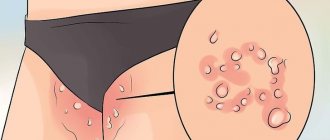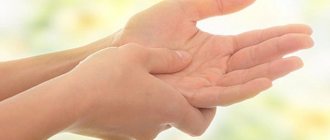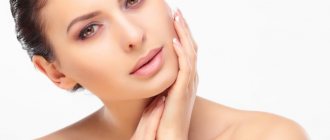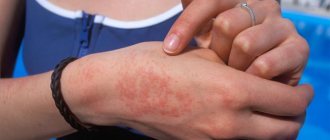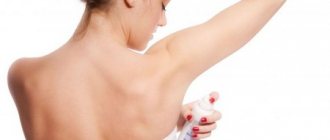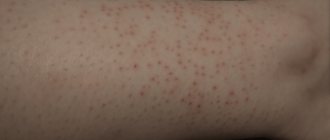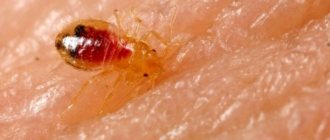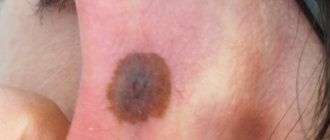What does it come from?
The main causes of problems include the following:
- Prickly heat. The cause of a small rash in a child may be exposure to high temperatures. That is why the problem is typical for the hot season.
- Allergic reactions. This disorder is accompanied by the formation of red rashes. They appear suddenly and often provoke a feeling of itching.
- Vaccination. Sometimes acne may appear after vaccination. Such a reaction should be a reason to consult a doctor.
- Influence of external factors. Acne on a child's face can occur under the influence of frost, wind, and ultraviolet radiation. All these factors have a negative impact on the baby's sensitive skin.
- Insufficient skin care. Young children's skin is highly sensitive. If it is contaminated, there is a risk of pustular rashes appearing.
- Insect bites. In some children, inflamed pimples are the result of insect bites. In addition to the nose, they can affect other areas of the body. Often there is a pronounced itching sensation.
- Acne of newborns. The cause of this problem is the increased content of hormones that are transmitted to the child from the mother.
- Puberty period. The appearance of acne during adolescence is associated with changes in the balance of hormones. During this period, the amount of male sex hormones increases. After the situation stabilizes, acne goes away.
Recommendations for rash around the nose
To prevent rashes in the area of the nasolabial triangle, general recommendations should be followed:
- Conduct a cosmetics audit. This will help you get rid of expired products that caused irritation;
- If you have a runny nose, use a paper tissue, which should be thrown away immediately. Wet tissues promote the spread of bacteria on the skin in the nose area;
- With frequent rashes, it is necessary to introduce more foods rich in minerals, vitamins and fiber into the diet;
- Change bed linen and towels more often;
- Use antibacterial facial skin care products.
Attention! Do not squeeze or scratch rashes and pimples in the nose area. The nasolabial triangle is the most vulnerable area of the face, which has no physiological protection. Infection of the rash in the nasal area can cause serious abnormalities and leave scars. In addition, the infection can enter the bloodstream.
Important: if you regularly experience a rash under your nose that is not related to your cycle, you should consult a doctor. You should not only conduct an examination by a dermatologist, but also check the internal organs for pathology.
In this article you will learn why redness and flaking of the skin under the nose occurs, as well as the reasons for the appearance of an unpleasant defect. You will understand which medications are suitable for treating skin, when and how to use them. You will receive several effective folk recipes for moisturizing and healing damage and learn how to use them correctly.
Causes
Causes of herpes symptoms under the nose:
- The primary type of disease is often provoked by airborne transmission of infection, when the herpes virus enters the body of a healthy person from an infected person.
- Secondary herpes under the nose can manifest itself throughout life when the immune system is weakened, since, having penetrated the human body once, the virus remains in it forever.
- Herpes on the nasal mucosa and under it can cause depression, vitamin deficiency, exacerbation of chronic diseases, complications of influenza and acute respiratory infections, and pregnancy.
If you start taking antiviral drugs on time and monitor your health, you will soon notice that the symptoms disappear.
Additional diagnostics
It is possible to accurately determine the condition that caused the rash under the baby’s nose based on the results of an additional study. After a clinical examination, the doctor will refer the patient for laboratory procedures:
- General blood and urine analysis.
- Blood biochemistry (hormonal spectrum, glucose).
- Serological tests (antibodies to infections and helminths).
- Allergy tests (skin tests, scarification tests, injection tests).
- A smear of rash elements, skin washes (cytology and culture).
- Coprogram and stool analysis for worm eggs.
If necessary, an ultrasound of the abdominal organs is also performed. The results of a comprehensive examination will show what changes are observed in the body and where their source is hidden. Treatment is prescribed in accordance with the diagnosis. And for parents who want to eliminate a rash under the child’s nose, it is important to rely on the doctor in everything and strictly follow his recommendations. rash under the child’s nose
Perioral dermatitis is a characteristic scaly, papular rash around the mouth, nose, and eyes that occurs almost exclusively in women. The rash may start around the mouth, but can also affect areas around the nose and eyes. The disease is asymptomatic, sometimes itching is noted.
Patients sometimes try topical steroids, which provide temporary relief but may contribute to a torpid progression.
Perioral dermatitis typically affects young women and can occur in children. Isolation of a Fusobacterium culture suggests a bacterial etiology. Routine use of moisturizing cosmetics and fluoridated products can cause the disease.
Symptoms
Pimples on a child's nose can have a variety of manifestations. Depending on this, doctors make one diagnosis or another.
Prickly heat
The baby's sweat glands are not well developed. That is why the processes of thermoregulation in children proceed differently.
One of the most common factors in the appearance of a rash is prickly heat, which is quite difficult to distinguish on your own.
The situation is further complicated by the fact that there are several types of prickly heat:
- Red - in this case, the skin changes its shade. In the most difficult situations, it turns bright pink. Rashes with cloudy contents appear on the surface. Red skin color is associated with inflammation.
- Crystalline - many bubbles filled with clear liquid appear on the skin. They burst when pressed. This form of prickly heat is not accompanied by redness.
- Papular - it is characterized by the appearance of pinpoint rashes. They can form large patches on the skin.
- Infected is the most difficult option. In this case, microbes penetrate into the wound formed when the bubble ruptures. Bacterial microorganisms lead to the development of inflammation. There is also a risk of purulent complications.
Possible diseases
Dryness and flaking of the skin near the nose may indicate a disease.
Pathologies and their symptoms are indicated in the table. Name
| Description | |
| Pathologies of the nasal cavity | Dryness and flaking of the skin may indicate rhinitis or sinusitis. The first disease is one of the most common pathologies of the respiratory tract. Rhinitis is an inflammation of the nasal mucosa of an infectious or non-infectious nature. Signs of the disease depending on the stage: 1. Dry irritation. Another name for the stage is dry. A person feels itching in the nose. Additionally, there is a constant desire to sneeze and tearing occurs. There is nasal congestion, so the sense of smell (the ability to detect odors) may be temporarily impaired. 2. Serous discharge. Another stage is called wet. A clear and watery secretion is released from the nose. The stage is characterized by a change in voice timbre due to swelling of the mucous membrane. 3. Mucopurulent discharge. Another name for the stage is purulent. The nature of the discharge changes. The secretion with pus becomes thick, the color can be yellow or green. If rhinitis is not treated, the disease will become chronic over time. In this case, the nose is constantly stuffy. Additionally, thick discharge is present, and hard crusts form in the organ cavity. With chronic rhinitis, there is a high probability of infection penetrating the pharyngeal mucosa. As a result, itching and redness in the throat and cough appear. Sinusitis is an inflammation of the mucous membrane of the sinuses (maximum, frontal, ethmoid). The disease can be caused by bacteria, viruses, allergens. Symptoms:
|
| Skin diseases | Common skin pathologies: 1. Dermatitis. Inflammation of the skin. The most common are contact, seborrheic, and atopic dermatitis. Symptoms include burning, itching, and swelling of the skin. Additionally, blisters form and redness is present. 2. Eczema. Chronic skin disease. Symptoms include inflammation and a rash on the skin. Additionally, there is a burning sensation. 3. Psoriasis. Chronic pathology of the skin. Symptoms include the formation of scaly plaques on the skin. 4. Ringworm. A disease in which various rashes appear on the skin (nodules, blisters, scales). Additionally, there is severe itching, redness, and dryness of the skin. 5. Herpes. A disease caused by the herpes simplex virus. Ulcers or blisters form on the skin or mucous membranes. 6. Demodectic mange. A pathology that occurs due to the penetration and reproduction of a tick. Its name is acne iron. Symptoms include a rash and a change in the appearance of the affected areas. In the evening and at night, itching and burning appear, since the peak activity of mites occurs at this time. 7. Rosacea. Another name is rosacea or acne. Symptoms include a change in the color of the skin - first it becomes pink and then red. Additionally, swelling of the skin appears. Spider veins and spider veins form on the epidermis, which are most often located near the nose. If the eyes are affected, the eyelids become swollen and red, and itching occurs. |
| Allergic reaction | Specific reaction of the immune system. If you are prone to allergies, the body perceives harmless substances as antigens (potentially dangerous). As a result, immunoglobulins are released that fight the components. Most often, allergies occur to pollen, food, and dust. A reaction to mold, wool, or insect bites cannot be ruled out. It is also possible to be allergic to medications and household chemicals.
|
| Avitaminosis | Lack of one or more vitamins in the body or problems with their absorption. Symptoms:
|
| Diabetes | A metabolic disorder in which there is insufficient production of one's own insulin, but increased levels of glucose in the blood. Symptoms:
|
| Acute respiratory diseases (ARI) | This group includes any infectious diseases of the respiratory tract that are accompanied by cold symptoms. Viruses and fungi can cause acute respiratory infections. Symptoms:
|
Prevention
As with any other disease, preventing a cold on the nose is always preferable to treating it.
Herpes is a highly infectious disease, so if you have a family member who is sick, you need to do everything necessary to prevent it from infecting others. For these purposes, the patient should wash his hands frequently, do not touch the source of inflammation with them, use only separate linen and dishes, and do not kiss other people.
After completing the procedure for applying antiviral ointment, you should get rid of all products (cotton wool, sticks).
To avoid relapses of herpes, you must adhere to the following preventive recommendations:
- hardening;
- proper nutrition;
- taking vitamins;
- avoid infection with ARVI, influenza;
- do not overcool the body;
- lead a healthy and active lifestyle.
Don't forget to strengthen your immune system. For these purposes, you need to lead an active and healthy lifestyle, give up bad habits, in particular smoking and alcoholism, maintain proper nutrition and constantly monitor the amount of vitamins necessary for the body in your daily diet.
By following all these simple recommendations for caring for your own health, a cold on your nose is unlikely to ever appear.
Loading…
Medicines
In case of severe disease, therapy should include systemic antiviral drugs. Often, in the initial stages of infection, you have to deal with the first episode of a cold.
The following medications, suppositories, and injections are used:
- Acyclovir;
- Zovirax;
- Valacyclovir;
- Valtrex;
- Famciclovir;
- Viferon;
- Genferon.
Antibacterial drugs and interferon derivatives prevent the too rapid proliferation of harmful microorganisms, so the pathology of the disease gradually subsides. In combination with them, it is necessary to carry out local therapy for colds in the nose, in order to quickly get rid of the symptoms.
Basically, it is recommended to lubricate the inside of the nasal mucosa, and therefore the following means are used:
- Erazaban ointment;
- Viru-Merz gels;
- Zovirax ointment;
- Zovirax patch;
- Panavir gels;
- zinc, salicylic ointments; Answer to the question: what does salicylic ointment mean? - read here.
- at the stages of the appearance of ulcers, they are treated with sea buckthorn oil and rose hips.
Treatment methods
Dry skin under the nose needs treatment. Doctors prescribe the use of medications, folk remedies and other methods.
Medications
Medicines help eliminate symptoms and alleviate a person’s condition. If dryness and flaking of the skin near the nose are signs that appeared due to exposure to natural factors, it is enough to use external remedies aimed at eliminating them.
Popular ointments, creams and gels:
Bepanten - ointment for healing wounds on the face and body
- D-panthenol.
- Pantoderm.
- La Cree.
- Solcoseryl.
- Baneocin.
- Children's cream (Johnsons baby, Avanta).
- Vaseline oil.
- Levomekol.
- Zinc ointment.
- antibacterial;
- antihistamines;
- antiseptic;
- antiviral.
- thiamine chloride solution;
- pyridoxine hydrochloride solution;
- cyanocobalamin solution.
If dryness and flaking of the skin are associated with a disease, additional medications are prescribed. The list of drugs depends on the specific pathology. The table indicates drug treatment for diseases that may indicate dry and flaky skin.
| Name | Method of drug therapy |
| Group of nasal pathologies | Drug treatment of rhinitis and sinusitis involves the use of the following groups of drugs: 1. Vasoconstrictors. The drugs reduce blood flow to the nasal mucosa. Additionally, the products eliminate swelling and congestion. The group includes Tizin, Rinostop, Afrin. 2. Cleansing the nasal cavity. It is recommended to use medications in this group before vasoconstrictors. The drugs cleanse the nasal cavity and relieve congestion. The group includes Aqualor, Aqua Maris, Dolphin. 3. Antihistamines. The drugs eliminate swelling. The group includes Erius, Claritin, Fenistil. 4. Antiseptic. The products are disinfectants and help reduce the likelihood of infection. The group includes Miramistin, Chlorhexidine. 5. Antibacterial. If the disease is caused by bacteria, this group of drugs may be prescribed. Medicines fight pathogenic microorganisms. Antibiotics include Amoxicillin, Amoxiclav, Klacid. 6. Antiviral. The drugs fight viruses. The group includes Ingavirin, Arbidol, Tsitovir-3. |
| Group of skin pathologies | The following drugs are prescribed for treatment: Additionally, they may recommend taking sorbents. For example, Polysorb, Filtrum-STI, Laktofiltrum. The drugs remove the pathogen from the body. |
| Avitaminosis | The remedy may vary depending on the deficiency of a particular vitamin. Most often it is recommended to use the following drugs in ampoules: Medicines in tablets: 3. Retinol acetate. 5. Undevit. |
| Diabetes | In case of illness, hypoglycemic drugs are prescribed that reduce glucose levels. The group includes Metformin, Siofor, Glidiab. For diabetes, insulin injections may be prescribed. The drug maintains normal glucose levels and reduces sugar spikes. |
| acute respiratory infections | The following medications are prescribed as therapy: 1. Nonsteroidal anti-inflammatory drugs (NSAIDs). Medicines lower the temperature. This group includes Nurofen, Ibuprofen. 3. Anti-colds. The drugs fight the symptoms of acute respiratory infections. The group includes Theraflu, Maxicold, Rinzasip. Additionally, vasoconstrictors and nasal cavity cleansers are prescribed. They also prescribe medicines for cough (Gerbion, Rengalin, ACC), throat (Grammidin, Strepsils, Tantum Verde). |
All medications must be prescribed by a doctor. Medicines have contraindications and side effects that need to be taken into account.
Traditional methods
To achieve high efficiency, it is recommended to use folk remedies in conjunction with other methods of therapy. Herbal recipes have a natural composition, so they rarely cause side effects.
Popular folk remedies that eliminate dry skin:
- Mask. To prepare you need to take 1 tbsp. vegetable oil and 1 tsp. mustard. Stir and add a few drops of water. Apply the mask to the skin, keep for 3 – 5 minutes. Rinse off and apply cream to the cover.
- Honey peeling. To prepare the recipe you need to mix 1 tbsp. honey with water so that the paste looks like sour cream. Rub the mask into the skin with massaging movements and hold for 5 – 10 minutes. Rinse off and treat the cover with cream.
- Dill decoction. To prepare you need to take 2 tbsp. component seeds and 500 ml of hot water. Boil the mixture over low heat for 10 – 15 minutes, filter through cheesecloth. Wait until it cools down, wash with the broth before going to bed. Apply moisturizer to skin.
- Vegetable mixture. To prepare the recipe, you need to peel and chop 1 banana, take 1 chicken yolk, 30 ml of low-fat sour cream. Mix everything to form a homogeneous mass. Apply the mask to clean facial skin, keep for 30 minutes, rinse.
Other methods
In addition to medications and folk remedies, other methods can be used to reduce dryness and flaking of the skin. They are listed in the table.
| Name | Description |
| Proper nutrition | Diet principles:
|
| Physical activity | There is no need to overload the body too much. Enough charging in the morning. It is also recommended to choose an additional activity - cycling, walking, swimming. |
| Salon treatments | Popular techniques to eliminate flaking and dryness of facial skin:
|
How to treat acne on a child's nose
Acne in children can be treated only after a detailed examination. It is performed by a pediatrician and a dermatologist. Sometimes consultation with specialized specialists is required - an immunologist, an endocrinologist, an allergist.
To cope with allergic acne, you need to make adjustments to the diet of the baby and the nursing mother. If other substances are the allergen, contact with them must be avoided. Sometimes it is not possible to do without antihistamines.
Rashes of infectious origin are treated with the medications prescribed by the pediatrician. Such pathologies often provoke a deterioration in the child’s general well-being. That is why it is so important to provide appropriate assistance in a timely manner.
To treat prickly heat, you should use special cosmetics. In this situation, it is recommended to use powder or baby cream that contains zinc.
Acne in newborns most often goes away in about six months and does not require specific therapy. To achieve cleansing of the skin, you can wipe it with a decoction of chamomile or string.
To speed up the recovery process, you need to follow certain recommendations:
- It is recommended to wash young children with boiled water 2-4 times a day;
- for bathing infants, you should use an infusion of chamomile or string;
- When bathing a baby, it is not recommended to use soap products more than 2-3 times a week;
- during water procedures, all cosmetics should be washed off well;
- It is recommended to remove food debris from the child’s face with napkins that do not contain alcohol;
- Children should not use products that are intended to care for the skin of adults;
- Squeezing pimples is strictly prohibited.
Causes and treatment
Redness or peeling under the nose is often perceived as a cosmetic defect that has nothing to do with illness. However, medical practice shows that skin changes occur under the influence of two groups of factors:
- environmental exposure;
- pathological changes in the body.
The first group is associated with negative weather or temperature conditions that provoke peeling and redness (burns, frostbite, chapping, etc.), mechanical effects on the skin. Treatment consists of selecting medications to protect the skin from aggressive external factors and heal wounds and microcracks.
The second group is associated with painful changes in the body, and peeling of the skin under the nose is only one of the symptoms of pathology. Treatment consists not only of healing and softening the skin, but also of eliminating the internal disease.
Drugs for the treatment of redness under the nose are selected only by a doctor based on an external examination and laboratory tests.
Dermatovenerologist Irina Igorevna Lazuk will talk about the causes of peeling of the facial skin under the nose and in the mouth area. After watching the video, you will understand when you should see a doctor and when you can get by with moisturizers at home.
Environment
The easiest way to cure redness under the nose is if it was the result of a burn or frostbite. To heal the skin, dermatologists recommend ointments:
- "Panthenol" (analogue of "Pantestin"). This is an effective dexpanthenol-based product that quickly heals wounds and microcracks. Dexpanthenol penetrates cells and turns into pantothenic acid, which accelerates tissue regeneration. To get rid of flaking, lubricate the skin under your nose up to 3 times a day.
- "Aekol" . A medicine based on an oil solution of vitamins A, K, E. It stimulates skin regeneration, acts as an antioxidant, and relieves inflammation. To treat redness, apply the ointment to a piece of gauze and apply to the affected area. Repeat the procedure 2-3 times a day until the skin heals.
- "Algofin" . A medicine based on chlorophyll-carotene paste. It destroys pathogenic bacteria, relieves inflammation and promotes healing. To get rid of peeling, lubricate the skin 2-3 times a day for a week.
- "Wundehil" . An ointment with a natural composition, which includes propolis, sophora, yarrow and other ingredients. "Wundehil" heals wounds well and accelerates regeneration. To get rid of inflammation, lubricate the skin 2-3 times a day for a week.
- "Methyluracil" . A healing medicine with the same active ingredient. It enhances regeneration and relieves inflammation well. Continue treatment for 2-3 weeks, applying the ointment to the skin under the nose 1-2 times a day.
- Sudocrem and zinc-based preparations. Zinc ointment, Sudocrem and its direct analogues, which contain zinc (for example, Bübchen cream), can relieve inflammation and improve skin condition within 1-2 days. Zinc promotes healing and protects the skin from external negative influences. 1 week is enough for a course of therapy. During this period, apply the ointment 1-2 times a day to the affected area.
Before choosing an ointment, consult your doctor. Some components of the medication may cause an allergic reaction.
Mechanical effect on the skin
Redness and peeling of the skin under the nose also occur due to mechanical effects:
- squeezing out blackheads or pimples;
- piercing;
- frequent use of breathing masks at risk of developing apnea and asthma.
This skin irritation does not require special treatment. Wound healing creams (Pantestin, Sudocrem) and eliminating the main cause of skin damage are enough.
Rosacea
One of the causes of redness under the nose is rosacea. This is the name of a disease characterized by persistent redness of the facial skin with the formation of papules, swelling, and pustules.
In addition to redness near the nose, other symptoms indicate rosacea:
- oily skin on the forehead;
- formation of red acne on the face;
- itching, dry eyes;
- periodic feeling of a rush of blood to the skin of the face.
Treatment of rosacea is complex and includes a number of measures:
- giving up bad habits (smoking, alcohol);
- diet excluding salty and spicy foods;
- taking antibiotics to eliminate pathological microflora (Tetracycline, Doxycycline, Minocycline) and the antiparasitic drug Metronidazole;
- local treatment with Skinoren gel or Ovante cream with crystalline sulfur to eliminate inflammation and swelling;
- the use of ointments with metronidazole “Metrogil”, “Rozamet”;
- taking vitamin preparations to strengthen the walls of blood vessels (“Ascorutin”, “Antistax”);
- use of antihistamines (Cetrin, Suprastin);
- physical therapy to smooth out the skin (dry ice treatment, liquid nitrogen therapy).
Rosacea is not a dangerous disease, but it causes a lot of discomfort and requires long-term treatment.
Dermatitis
The cause of redness can be 2 types of dermatitis:
- perioral;
- seborrheic.
Perioral dermatitis occurs as a result of rosacea, infectious skin lesions, as well as the use of certain toothpastes, hormonal creams and cosmetics. The disease is characterized by redness of the skin, itching and peeling.
Seborrheic dermatitis most often occurs on the scalp, but can also affect areas of the skin on the face. The disease is characterized by peeling of the skin, while the feeling of excessive sebum secretion persists.
Stages of development
- The pathology of the disease is always the same and is an increasing itching and burning sensation in the area where the bacteria are activated. The skin first becomes red and noticeable.
- The skin begins to itch and burn two days before the rash, after which a significant number of small blisters appear, which consist of a light liquid - an infiltrate that gradually becomes cloudy.
- The blisters burst, creating ulcers. If there are many lesions, they can merge, resulting in significant erosion.
- After a few days, a crust appears at the site of erosion, which quickly dries out. Everything lasts about a week, after formation they go away, in the absence of exacerbations with the participation of any harmful microorganisms.
Recurrence of the disease can occur either once a year or after 2 months. The reason for such an exacerbation should be found in accompanying diseases, primarily in weakened immunity.
Preventive measures
Let’s immediately make a reservation that a huge part of ophthalmological problems (including pathological itching) can be avoided if you follow the following preventive instructions:
- compliance with personal hygiene standards;
- minimizing contact with allergens (if we are talking about allergies to certain substances);
- protecting your eyes from the harsh sun (wearing sunglasses);
- taking regular breaks when working at a computer for long periods of time, as well as doing eye exercises.
Sunglasses
And most importantly: do not ignore any (even the most seemingly harmless) suspicious symptoms! And the video below will tell you why eye itching occurs and what to do about it.
Video - Itchy and teary eyes
Itching in the corners of the eyes causes a lot of inconvenience to a person.
The nasty symptom can be caused by specks that get into the eye or serious bacterial diseases. You need to contact an ophthalmologist as soon as burning and redness occur.
When the inner corners of the eyes itch, a person feels discomfort and loses concentration.
In this article, we will carefully tell you about additional symptoms, causes and methods of treating itching in the corners of the eyes.
Treatment
If pimples are the result of a sexual crisis, then no treatment is required. The newborn is provided with routine care and hygiene procedures. In case of heat rash, it is necessary to ensure a normal temperature in the room and not to wrap the baby too tightly, devoting several hours a day to air baths. Local therapy involves the use of creams or powders (for example, Bepanten).
Diathesis during breastfeeding requires the exclusion from the mother's diet of foods with possible allergenic properties (eggs, red vegetables, citrus fruits, nuts, chocolate, seafood, etc.). If the child is fed an artificial formula, then it will have to be changed to another. They use drugs with antiallergic properties (sodium bromide, Suprastin, Fenistil), bathe the child in herbal infusions (chamomile, chamomile, oak bark).
Children's infections of a viral nature (measles, rubella, chickenpox) in most cases are treated nonspecifically. Antipyretics and antihistamines, interferon preparations and vitamins are prescribed. For chickenpox, the elements of the rash are smeared with antiseptics (diamond green), and measles requires eye washing and rinsing (in older children). But children with scarlet fever are prescribed antibiotics to which streptococcus is sensitive (penicillins, cephalosporins, macrolides).
A rash on a child’s face and nose cannot leave parents indifferent. It is necessary to find out why it arose and whether it poses any danger. But only a doctor will accurately determine the cause of the changes and tell you how to eliminate them.
Questions for a specialist
Question: My eyes are watering due to a runny nose, I’m already completely tired of it, what should I do?
Answer: Find out the cause of this condition. If you have a cold, then the treatment is one, but if you have an allergy or another disease, then it’s completely different.
Question: If my left eye is watery and I sneeze a lot when working with wood, could this be a sign of an allergy?
Answer: Yes, it can. To confirm the diagnosis, allergy tests must be performed.
Question: I have watery eyes and a runny nose, I sneeze and cough often when I have any cold. This is fine?
Answer: These symptoms are completely normal for your condition. In this way, the body tries to cope with the infection. If they bother you too much, you can pick up medications and reduce the symptoms of a cold.
Watery eyes and rhinitis are symptoms of various nasal diseases. These symptoms almost always accompany colds, sinus infections, and allergies.
In some cases, such manifestations may be the first sign of neoplasms or foreign bodies in the area.
If symptoms persist for a long time and doubts arise, you should undergo a full examination by a specialist.
Allergies and nutrition
Often the causes of an allergic reaction followed by a rash on the nose lie in food. Allergies usually appear as red, scaly, itchy patches. Treatment involves taking antihistamines and eliminating provocateurs from the diet and environment.
But, in addition to allergies, an unbalanced diet itself can act as a cause of inflammation of the sebaceous glands.
Fatty, fried, spicy, salty and poor-quality foods can provoke metabolic disorders, which, in turn, causes gland dysfunction and blockage of the sebaceous ducts. By reviewing your diet and eliminating all harmful foods, you can get rid of inflammation on your own. It will not hurt to use anti-inflammatory, antiseptic solutions to treat affected areas of the skin.
General recommendations and prevention
To avoid the formation of redness and peeling under the nose and speed up skin healing, doctors recommend the following measures:
- Avoid using low-quality cosmetics that can cause allergies and irritating products (alcohol tinctures, methanol, facial scrubs). If you have skin problems, do not use hormonal ointments and creams without your doctor's knowledge. Progesterone pills for women can worsen the condition of the skin.
- Do not rub the affected area of the skin, do not squeeze out pimples and pustules. Do not pick off flaking skin: to remove dead epithelium, first moisten the affected area with water.
- In cold weather, apply a rich cream or natural fat, such as goose fat, to the skin around the nose. Do not use vegetable oils for these purposes: they greatly dry out the skin and worsen their condition.
- Avoid bad habits such as drinking alcohol or smoking.
- Eat healthy foods, avoiding overly salty and bitter foods.
- In the autumn-spring period, take vitamin complexes (Vitrum, Aevit) to strengthen the immune system and improve skin condition.
- In severe cases, in the absence of contraindications, resort to cosmetic procedures, such as chemical peeling.
Boils
Furunculosis is provoked by staphylococcal infections and pyogenic bacterial flora. The disease manifests itself in the form of purulent inflammation with necrotic damage to the connective tissue, sebaceous gland and hair follicle. On the face, the area of the wings of the nose is considered more susceptible to the occurrence of boils.
To treat furunculosis, antiseptics, drugs that eliminate inflammation, and physiotherapy are prescribed. After the boil opens, it is treated with antibacterial agents. The doctor should also prescribe antibiotics to treat the staph infection.
Pimples appeared around the mouth and nose. What are the reasons and what to do?
In addition to the above reasons, the appearance of acne around the mouth and nose can be the result of various colds or simple hypothermia. Such pimples are not purulent, but have a reddish tint and are small in size.
Such rashes do not require special treatment and usually go away with a decrease in the main symptoms of the disease.
Also, pimples around the mouth can occur due to improper functioning of the digestive system or a lack of certain vitamins, in this case, group B. Correction of diet and lifestyle will help return your face to its original condition. We also recommend this video from a dermatologist:
When should you see a doctor? Diagnostics
A certain proportion of patients are not inclined to perceive the signs of a runny nose and congestion as a serious illness. As a result, the symptoms are simply ignored, and the disease develops into severe chronic forms.
Diseases at an advanced stage are much more difficult to treat and can even cause complications such as meningitis, orbital phlegmon, brain abscess, and eyelid edema.
If you have an elevated body temperature that persists for 2-4 days, heavy discharge, a feeling of heaviness and discomfort in the nasal sinuses, you should definitely contact an otolaryngologist. The following methods are used to diagnose the disease:
- general examination and palpation;
- radiography;
- CT scan;
- endoscopy.
If there is reason to suspect an allergic origin of the inflammatory process, an allergen test is indicated. Once the disease is identified, treatment is prescribed.
Read more: X-ray of the sinuses: description of the procedure. Reviews, price
CT scan of the nasal sinuses: what does it show? Full description of the procedure. Price
Why do eyes itch and runny nose appear with allergies?
Despite the fact that allergies do not lead to general intoxication of the body and do not increase a person’s body temperature, it significantly reduces the patient’s performance and quality of life in general.
After all, it’s impossible to write, read, or even just look normally when your eyes are terribly itchy. If the nose is stuffy and colorless mucus flows from it, this also leads to a decrease in activity, because oxygen begins to flow worse to the brain, drowsiness and irritability appear. Allergens are foreign substances to the body. And with everything alien, and even potentially dangerous, nature fights with force. Naturally, the body activates all its forces to fight and tries to get rid of the enemy by any means necessary. Liquids are considered the best option for this.
At the same place where the allergen has settled, an inflammatory process begins, which leads to swelling. As a result, the outflow of mucus is disrupted and allergic rhinitis begins. It is worth considering that allergic rhinitis is treated with completely different means than infectious rhinitis. The only thing they have that is similar is vasoconstrictor drugs. It is necessary to supplement the treatment regimen with antiallergenic drugs.
Often, if a person has an allergy, he begins to sneeze a lot and often. However, his condition does not improve with each sneeze. In fact, this reaction is also caused by the body to clear the airways of the allergen.
Itchy eyes
Itchy eyes due to allergies occur for exactly the same reasons as in the case of rhinitis. The allergen settles on the mucous membrane of the eye and causes irritation. Naturally, the body begins to fight, opening lacrimation. Since the allergen irritates the skin, it begins to itch, resulting in puffy and puffy red eyes.
What to do?
If you react to flowering, you can try to plan a vacation precisely for this dangerous period for you and go to a place where flowering begins later or earlier.
In addition, you should adhere to the general list of recommendations, for example, ventilate the room after rain, do not go outside early in the morning or on a dry hot day, when the concentration of pollen and other potential allergens is at a maximum, take a shower often, dry things only at home, because . outside, pollen settles on them, etc.
There are other diseases with which these symptoms can be confused:
- Fatigue – after being tired, working at a computer for a long time or lack of sleep, a person experiences a feeling of dry eyes, and redness may appear. But this symptom is rarely combined with congestion.
- Infectious conjunctivitis is formed as a result of infection of the mucous membrane of the eye by bacteria. The disease is manifested by irritation, pain and burning, redness of both the mucous membrane and the eye itself, often with purulent discharge.
- Demodectic mange is a specific disease caused by a microscopic mite that lives inside the skin of the face. The main symptoms include intense itching, swelling of the eyelid, loss of eyelashes, fatigue and dry eyes. Demodectic mange is often confused with ordinary eye fatigue. As the disease progresses, crusts may appear at the edge of the eyelid and sticky mucous discharge after sleep. Mite damage to the mucous membranes of the eyes can also be combined with damage to the nasal cavity, resulting in congestion and swelling.
- A cataract is a clouding of the lens of the eye. In most cases, the disease develops in older people. Its signs: increased sensitivity to bright light, distortion of objects and their bifurcation, deterioration of vision at dusk.
- Barley occurs as a result of a staphylococcal infection entering the body. Symptoms appear almost immediately: a slight swelling on the edge of the eyelid, swelling and inflammation around it.
- Trachoma is a chronic eye disease caused by chlamydia. There is a strong burning sensation and foreign body sensation, swelling of the mucous membrane, purulent discharge, and photophobia. Trachoma can be combined with viral diseases, which cause nasal congestion.
- Dry eyes occur when working at a computer for a long time, dry indoor air or the presence of toxic substances in it. Combined with nasal congestion and dryness of the mucous membranes in it.
Erysipelas
Erysipelas is observed when the blockage of the sebaceous glands was caused by group A streptococcal flora. The disease manifests itself in the form of local redness on the nose, spreading to the area of the nasolabial triangle and the upper lip. The inflamed area has a clear outline. In addition, there is swelling of the affected area and pain even with a light touch. In some cases, watery small blisters appear that contain gray fluid.
Antibacterial drugs are used as treatment. You should not do warming compresses or other procedures, especially without consulting a doctor.
Thus, the causes of inflammation on the nose, as well as under the nose, can be completely different. Their manifestations on the skin may also differ. The main thing is to identify the main cause of the disease in time, and then begin to properly treat the disease. Nasal boil
- acute purulent inflammation of the hair follicle and sebaceous gland on the outer or inner surface of the wing of the nose, tip of the nose, skin of the nasal septum. Boils are most often located on the tip and wings of the nose, in the vestibule, near the nasal septum. Acute purulent-necrotic inflammation of several hair follicles and sebaceous glands with extensive necrosis of the skin and subcutaneous tissue of the nose is called a carbuncle.


